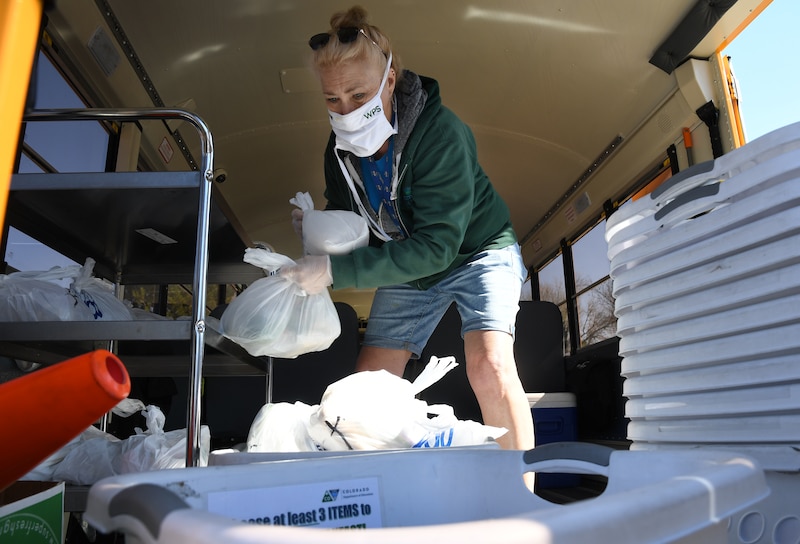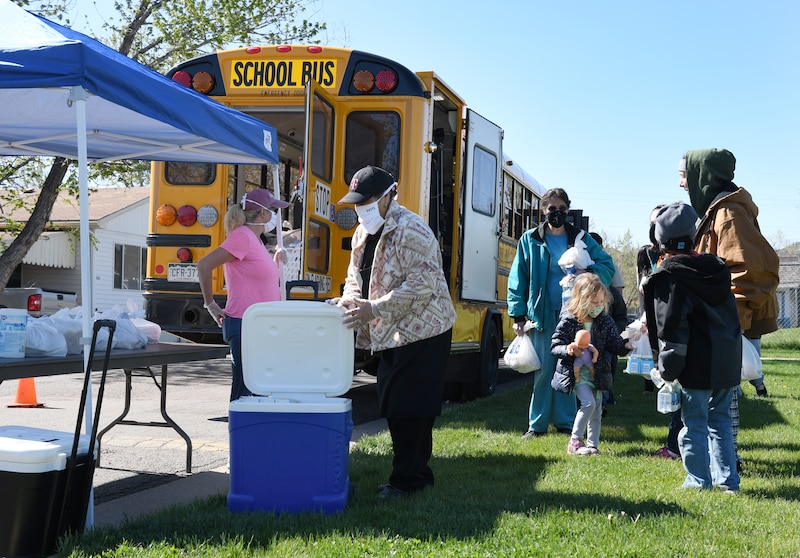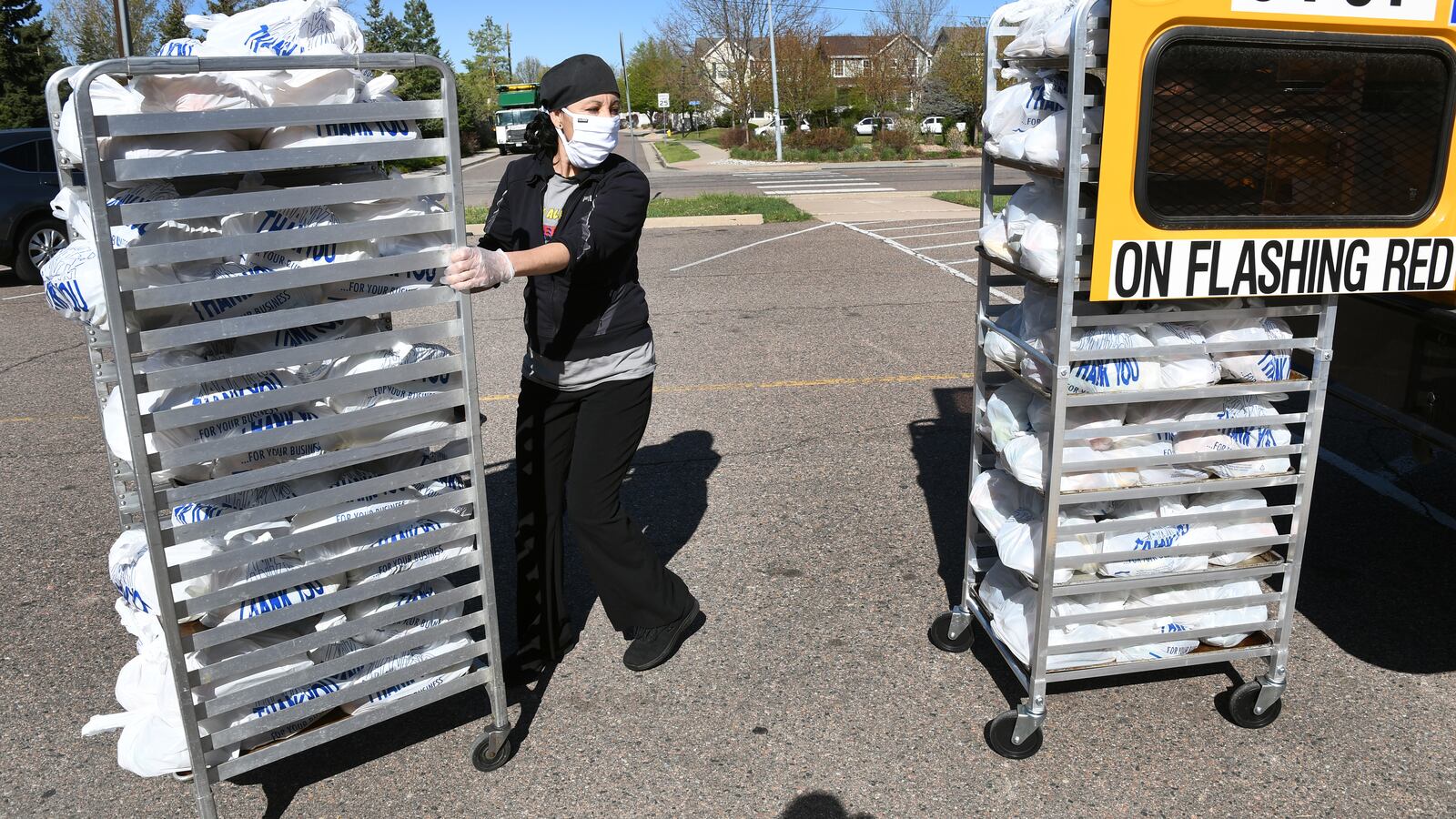One of the first considerations for any school district thinking about closing school, even for a single snow day is: How will children eat?
As schools across Colorado closed in March to slow the spread of coronavirus, food service directors and cafeteria workers swung into action, setting up an extensive network that has handed out hundreds of thousands of meals, many of them to families short on food for the first time.
But despite extensive efforts and growing need, these meals remain millions short of what districts would have served in normal times. Districts have been unable to approach pre-pandemic meal counts for a range of reasons, including confusion over the rules, lack of transportation, and narrow pickup windows that don’t meet the needs of harried parents.
The districts that have bucked this trend, like Westminster Public Schools, have done so by leveraging strong community networks and ramping up delivery options.
A Chalkbeat analysis of data from the first month of food distribution found that many metro area school districts are serving less than half of the meals they would have served if school were in session, in some cases much less.
Don’t see the graphic above? Click here.
During the first month of school closure, Denver Public Schools served just 12% of the student meals it usually serves while Jeffco Public Schools served just 16% of what it normally would have served to students. Some districts are reaching a larger share of students, like Aurora Public Schools at 34% and Adams 12 Five Star Schools at 57% of their normal meals. Westminster Public Schools, meanwhile, is providing 125% of the student meals it did when school is in session.
The lower numbers don’t mean a lack of need, advocates said. Paola Babb of Hunger Free Colorado said calls to the group’s food hotline have tripled. They’re processing more food stamp applications than ever, and food banks are seeing more customers than ever.
“We’re seeing huge need across the state,” she said.
Hunger Free Colorado provides families with children information about school sites along with neighborhood food pantries.
“The schools are a linchpin in their community,” said Jessica Wright of LiveWell Colorado, a group that works to improve access to healthy food. “The ability for them to still serve meals is critical. The food banks are overwhelmed and if the schools shut down food distribution, I would really hate to see the fallout.”
Busy lives, confusion, and shame make it harder to reach families
Because most districts are giving out multiple meals at once, the families that come to school sites often are getting more food for their children than they did during the school year, when many students ate lunch but not breakfast. And many schools have added weekend meals and food for adults, neither of which they offered during the school year.
But schools are not reaching nearly as many students.
There are a lot of reasons why more families aren’t taking advantage of these free meals. Some parents don’t have transportation. Others, especially those with younger children, find it difficult to get everyone loaded into the car and make it to a narrow pick-up window.
“Noon comes but I’m so busy, how do I go out?” said Xiomara Blanco, a Jeffco mother of two children, one with special needs. “By the time I get them both in the car with me, time’s up and so I’d rather make their meals myself.”
Others don’t want to be seen taking a handout.
“They want to do this in a very discreet way,” said Papa Dia, who runs a community organization that helps African immigrant families in Denver and Aurora. “We just drop it by the door and leave.”
There’s also uncertainty about what, exactly, the rules are. Many districts from the start tried to make meals as easy to access as possible. Children did not need to be students at a particular school, in a particular district, or even students at all, to get meals, which are freely handed out to anyone aged 1 to 18. No one was asked for identification. But children did have to be present to get a meal.

Many districts have relaxed that requirement, but confusion abounds. Despite assurances, some immigrant families fear they’ll risk their immigration status or potential citizenship if they take free food.
Gladys Soto, a Denver parent, and group leader with the education advocacy group CLLARO, said people wonder if they have to take their kids, if they have to show an identification, or if they have to live in the neighborhood. And they wonder if all they’ll get is canned food.
“The district just assumes everyone is going to understand what they’re saying,” Soto said. “There’s still lots of families that you have to break it down, step by step.”
Serving meals in a pandemic brings its own challenges
To keep serving students, food service directors across Colorado have had to overcome major hurdles. There have been shortages of bread and milk, paper bags and food cartons, gloves and masks. When there are shortages, districts have to get waivers from nutritional requirements or spend more to meet them.
Several suburban districts told Chalkbeat they break even on meal distribution through a combination of careful purchasing and staffing decisions, donations, and reserves built up when their school lunch programs were profitable. But the Denver school district expects to lose $5.7 million by the end of the fiscal year on meal service since schools closed. A national study from the Urban Institute and LiveWell Colorado’s survey of food service directors both found many programs operating at a loss, which raises questions about sustainability.
Schools have had to change kitchen work flows so that fewer workers standing further apart can still prepare large quantities of food. They have to keep cold food cold and hot food hot at outside grab-and-go stations and on long delivery routes. Food service workers have had to quarantine after getting sick or being exposed to an ill person. Many food service workers are older or care for family members who are in high-risk categories.
Many districts have implemented rotations to give employees a break from the stress and are offering hazard or “thank you” pay to those who come in.
“It’s not like I can say, ‘Let’s open you up and serve as many meals as possible,’” said Theresa Hafner, executive director of food services for Denver Public Schools. “I have to say, ‘I can only put three of you in there. How many meals can we produce?’”
Denver, where roughly two-thirds of students qualify for subsidized lunches, a measure of poverty, started its food distribution program at 12 schools where a lot of students normally eat lunch, but as the numbers started to come back, officials realized they were missing too many families.
The district added school sites and delivery along bus routes in high-poverty neighborhoods and to apartment complexes with lots of children. Demand at the Montbello campus in northeast Denver, one of the district’s busiest distribution sites, didn’t go down at all when other sites opened nearby.
Nonetheless, by mid-April the district was serving roughly 3,900 lunches a day, compared with 45,000 lunches a day when school is in session, three-quarters of them to students from low-income households.
Wright, with LiveWell Colorado, sees food service directors being creative and resourceful, with some even offering meal kits for families to assemble at home when school staff couldn’t safely cook and store the food they had on hand.
But at the end of the day, it’s hard to replace a school cafeteria and a fully staffed kitchen.
“Now we have these grab-and-go meals with prepackaged items that may not be as appealing and may not be what families want,” she said.
Don’t see the graphic above? Click here.
Making meals work for families
Wright said districts often have good reasons for changing meal sites and distribution schedules, but the constant changes make it hard to provide the most up-to-date information.
Districts that have added delivery routes often reach a higher percentage of their families in poverty, Wright said, and many food service workers and bus drivers relish the opportunity to see “their kids” again.
The Adams 12 Five Star district distributes food three days a week at five comprehensive high schools, but that can be a walk of up to three miles. After identifying those in need, the district began delivering food and even personal hygiene items to 600 families — and plans to add more.
“We are just committed to getting the food and supplies to those families. If we’re going to err, let’s err on the side of humanity and compassion,” said Pat Hamilton, the district’s chief operating officer.
Rocky Mountain Prep charter network in Denver and Aurora set up its own meal sites, but also bought $10,000 worth of grocery store gift cards and authorized trusted employees to hand them out to those with the most need. CEO and founder James Cryan said the network had to shift from running schools to being “a food supplier, tech support organization, and dramatically undertrained social work service.”
In Aurora, food services director Shannon Solomon said that the district increased participation by keeping consistent sites and times and by using colorful decorated buses to serve as a visual cue.
To discourage socializing and reduce potential exposure, the district keeps a tight 30-minute window to hand out food but added two lines to speed pickups. And realizing that some families were busy, Aurora made it easier for neighbors to pick up food for each other.
The biggest challenge right now? Solomon is “desperate for bags” and has shifted to bulk packaging.
Delivery options and word of mouth help some districts reach more families
The suburban Westminster district, where 78% of students qualify for subsidized lunches, is serving more meals than ever before by taking food into the community and leaning on neighborhood networks to get the word out.
After starting with four pickup sites, the district has added eight “bus stop sites” in areas where lots of students live. Some families that can’t leave their houses get a week’s worth of meals delivered.
“The district has taken the position that they want to feed all the kids they can,” said David Maki, Director of Culinary Service for Chartwells, the food service company that took over the district’s food service program 10 years ago.

And the district is also relying on word of mouth.
“The community thought they had to sit there and eat on site, and that’s why at first they didn’t want to go,” said Lorena Osorio, a mom of two Westminster students.
Osario works as a volunteer with El Centro Humanitario to get more people in her community to fill out the Census. As job losses swept through so many families, she started telling everyone that the district was serving emergency meals — and the food is good. Now people share with each other what’s available.
A typical meal includes a sandwich — that could be a chicken patty, hamburger, turkey and Swiss among other options — fruit, vegetables and milk. The district has also served tacos, baked ziti, chicken Alfredo, and fajitas.
“Even the vegetables and fruit that they give are very good quality,” Osorio said.
Questions about sustainability
The Urban Institute recently looked at food distribution methods in urban and rural districts across the country and found schools grappling with many of the same challenges faced in Denver area districts. Researchers also raised concerns about the long-term sustainability of school-based food distribution.
Adding delivery service and navigating supply chain problems raise the cost of meal service even as districts are taking in less money and bracing for bigger budget cuts. Schools need to be “made whole” for the community service they’ve performed, said Elaine Waxman, a senior fellow at the Urban Institute, and perhaps they should carry less of the burden going forward.
Expanding eligibility for food stamps and for “pandemic EBT,” a purchasing card with the value of school lunches, would allow more families in need to just buy food, she said.
But in the immediate aftermath of school closures, there were no other organizations as well suited as schools to step into the gap.
“We don’t have a comprehensive family policy in this country,” Waxman said. “That’s what schools are.”
Data analysis and visualizations by Gabrielle LaMarr LeMee. Senior reporter Melanie Asmar also contributed reporting.

